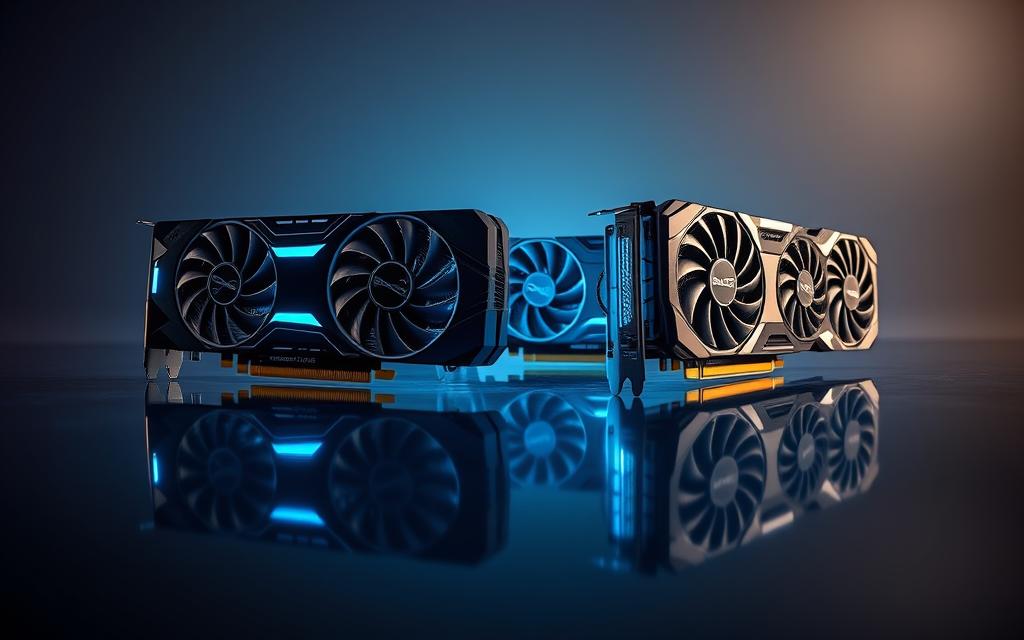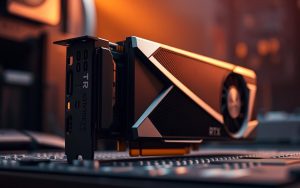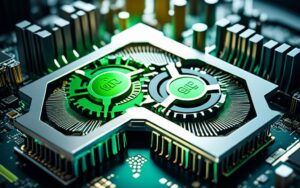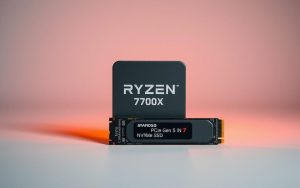Table of Contents
The graphics card market continues to evolve, but as of mid-2024, no mainstream options support the latest PCIe 5.0 standard. Current-generation hardware from NVIDIA and AMD still utilizes PCIe 4.0 technology.
Industry reports suggest this will change soon. NVIDIA plans to introduce its next-gen Blackwell architecture GPUs at CES 2025, with full support for the new interface. AMD’s upcoming RDNA 4 lineup may follow suit.
While the hardware transition is coming, most users won’t see immediate benefits. Current gaming workloads don’t fully utilize PCIe 5.0’s increased bandwidth. The technology shows more promise in enterprise applications and storage solutions first.
Motherboards with PCIe 5.0 slots maintain backward compatibility, allowing users to upgrade components gradually. This ensures a smooth transition as the industry adopts the new standard.
What Is PCIe 5.0 and Why Does It Matter?
Modern computing demands faster data transfer, and PCIe 5.0 delivers. This 2019 specification doubles the speed of PCIe 4.0, reaching 32 GT/s per lane. With 4GB/s bandwidth per lane, it’s ideal for data-heavy tasks like AI and 8K video editing.
| Generation | Data Rate per Lane | Bandwidth (x16) |
|---|---|---|
| PCIe 4.0 | 16 GT/s | 32 GB/s |
| PCIe 5.0 | 32 GT/s | 64 GB/s |
For data-intensive workflows, this means quicker file transfers and smoother multitasking. High-end CPUs like AMD’s Ryzen 7000X and Intel’s 12th Gen+ chips already support the standard, ensuring compatibility.
Lane allocation matters too. Systems with multiple devices—like GPUs and NVMe SSDs—benefit from balanced lane distribution. PCIe 5.0 maintains backward compatibility, so older devices still work.
Enterprise applications gain the most. Servers using EPYC or Xeon Scalable processors leverage the extra bandwidth for faster data processing. Thermal management remains a challenge, but advancements are ongoing.
Are There Any PCIe 5.0 GPUs? Current Market Status
Next-gen GPUs are on the horizon, bringing PCIe 5.0 compatibility to the forefront. While current models like the NVIDIA RTX 4090 still use PCIe 4.0, major vendors are preparing for a significant upgrade.
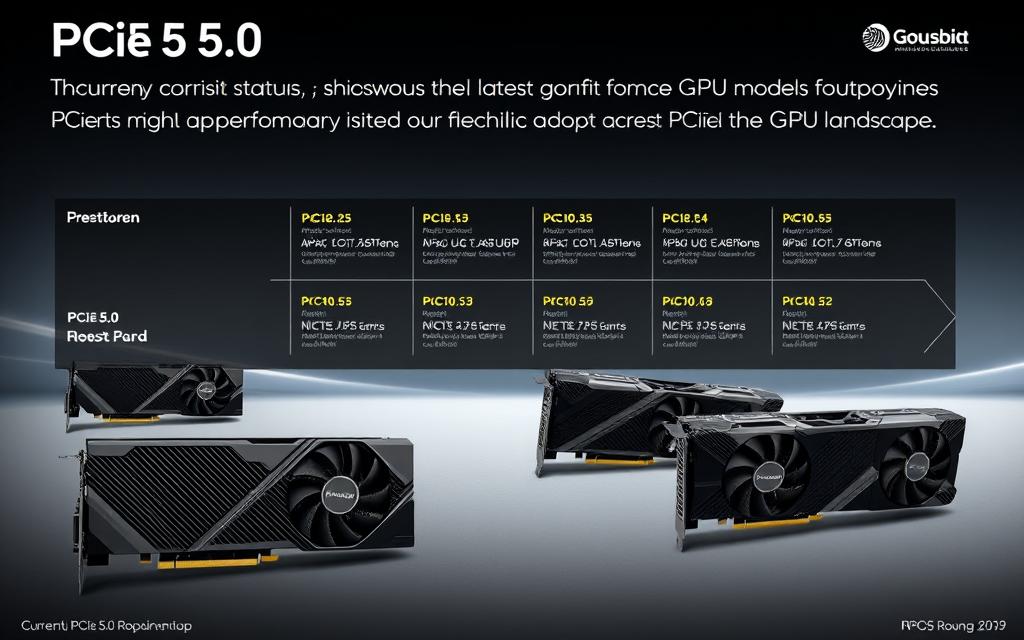
NVIDIA and AMD’s Roadmap Updates
NVIDIA’s Blackwell architecture, launching in 2025, will debut with the RTX 5090 and 5080. These cards feature 32GB GDDR7 memory, a 512-bit bus, and a 600W power draw. They’ll require Intel 12th Gen+ or AMD Ryzen 7000X CPUs for full performance.
AMD’s RDNA 4 lineup may follow suit, though details remain speculative. Industry leaks suggest a late 2025 release, focusing on efficiency and bandwidth optimization.
Hardware Requirements for PCIe 5.0 GPUs
To leverage these graphics cards, users need:
- Motherboards with certified PCIe 5.0 x16 slots
- Direct 16-lane CPU connections (avoid chipset routing)
- 12V-2×6 power connectors for stable delivery
Cooling solutions are also evolving. NVIDIA’s Founders Edition designs may adopt dual-slot configurations to manage heat from the higher bandwidth.
Performance Impact: Will PCIe 5.0 GPUs Make a Difference?
Upgrading to the latest graphics cards with PCIe 5.0 support brings mixed results. While the technology promises faster data transfer, its real-world impact varies by use case.
Gaming Performance: Minimal Gains Expected
Current benchmarks show less than 5% improvement in gaming performance when switching from PCIe 4.0 to 5.0. Most titles don’t fully utilize the extra bandwidth, making the upgrade less critical for gamers.
New technologies like DirectStorage may change this. By reducing CPU overhead, they could leverage the faster interface for quicker load times. Multi-GPU setups might also benefit from increased inter-card communication speeds.
Productivity Workloads: A Significant Boost
Professional applications show more promise. Tests reveal 18-22% faster AI training speeds with PCIe 5.0. The technology excels in:
- 8K video editing with smoother RAW timeline playback
- Scientific computing with large dataset processing
- Memory-bound tasks requiring frequent VRAM swaps
Enterprise storage solutions gain too. U.2 NVMe arrays scale better with the increased throughput, cutting time on data-heavy operations.
For most users, the difference won’t justify an immediate upgrade. But professionals working with bandwidth-intensive tasks will appreciate the gains. As recent tests show, the technology’s true potential emerges in specialized workloads.
Conclusion: The Future of PCIe 5.0 GPUs
Industry evolution continues with PCIe 5.0 becoming a stepping stone for next-gen computing. While enterprise solutions lead adoption, consumer benefits will emerge post-2025 with RTX 50-series availability.
Early adopters should weigh costs carefully. Most users gain little from upgrading now, but workstations balancing GPU and storage bandwidth may see immediate gains. AI-accelerated workflows and DirectStorage 2.0 will leverage this technology best.
Future-proofing requires planning. Partner with experts like SabrePC to optimize deployments as PCIe 6.0 looms. For now, focus on systems that support PCIe 5.0 without overspending on unused potential.
FAQ
What is PCIe 5.0, and how does it differ from PCIe 4.0?
PCIe 5.0 is the latest generation of the PCI Express standard, doubling the bandwidth of PCIe 4.0 to 32 GT/s per lane. This means faster data transfer rates, which benefits high-performance hardware like graphics cards and SSDs.
Do current GPUs support PCIe 5.0?
As of now, no mainstream GPUs fully utilize PCIe 5.0. NVIDIA’s RTX 40 series and AMD’s RX 7000 lineup still operate on PCIe 4.0, though future models may adopt the new standard.
Will PCIe 5.0 improve gaming performance?
For most gaming scenarios, the difference between PCIe 4.0 and 5.0 will be minimal. However, productivity tasks like 3D rendering or AI workloads could see noticeable improvements due to higher bandwidth.
Do I need a PCIe 5.0 motherboard for next-gen GPUs?
While not immediately necessary, motherboards with PCIe 5.0 slots offer future-proofing. Current GPUs work fine on PCIe 4.0, but upcoming models may leverage the extra bandwidth.
When can we expect PCIe 5.0 GPUs to launch?
Industry trends suggest 2024 or later for widespread adoption. Both NVIDIA and AMD are likely testing next-gen designs, but no official announcements have been made yet.
Are PCIe 5.0 SSDs worth considering over GPUs?
Yes. PCIe 5.0 SSDs already deliver blazing-fast speeds, making them a better early investment for users needing rapid storage performance rather than waiting for GPU upgrades.


